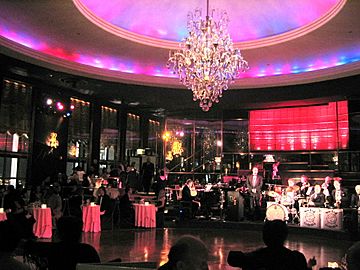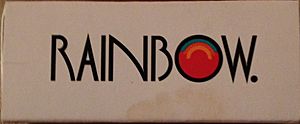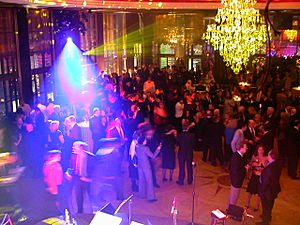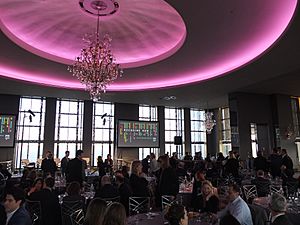Rainbow Room facts for kids
Quick facts for kids Rainbow Room |
|
|---|---|
 |
|
| Lua error in Module:Location_map at line 420: attempt to index field 'wikibase' (a nil value). | |
| Restaurant information | |
| Established | October 3, 1934 (original restaurant) |
| Current owner(s) | Tishman Speyer |
| Head chef | Mathew Woolf |
| Food type | Classic and contemporary American |
| Dress code | Jackets required (for men only) |
| Street address | 30 Rockefeller Plaza |
| City | New York City |
| State | New York |
| Postal/ZIP code | 10112 |
| Country | United States |
| Coordinates | 40°45′32″N 73°58′44″W / 40.759°N 73.979°W |
| Seating capacity | 300 |
| Reservations | Required except on Sunday mornings and Monday nights |
The Rainbow Room is a private event space on the 65th floor of 30 Rockefeller Plaza at Rockefeller Center in Midtown Manhattan, New York City. Run by Tishman Speyer, it is among the highest venues in New York City. The Rainbow Room serves classic and contemporary American cuisine.
Opened in 1934, it was a focal point for the city's elite as well as one of the United States' highest restaurants above ground. Due to World War II, the Rainbow Room was closed from 1942 to 1950. The restaurant received renovations in 1965 and 1985–1987, both of which sought to restore its original 1930 decor. Suffering from a decline in business following the financial crisis of 2007–08, the Rainbow Room closed in 2009. The restaurant reopened in 2014 following a renovation.
In 2012, the Rainbow Room was declared a landmark by the New York City Landmarks Preservation Commission. In 2017, the American Institute of Architects gave the Rainbow Room an award for outstanding interior architecture. Since the Rainbow Room reopened in 2014, its food has received positive reviews, but has been described as very expensive.
History
Context

During the 1920s, John D. Rockefeller Jr. had conceived the site of the current Rockefeller Center as a location for the Metropolitan Opera, but these plans were shelved and the plans eventually evolved into a mass media complex, leading to the construction of Rockefeller Center. The complex's flagship RCA Building (now 30 Rockefeller Plaza) opened in May 1933. Shortly after the RCA Building's opening, there were plans to use the space above the 64th floor as a public "amusement center". That section of the building had several terraces, which could be used to construct a dance floor, observatory, restaurant, and landscaped terrace gardens. Frank W. Darling quit his job as head of Rye's Playland in order to direct the programming for the proposed amusement space.
Many of New York City's buildings in the 1930s had restaurants or exclusive clubhouses on the top floors of their buildings. This stemmed from a tradition that started in the late 19th century, after the introduction of elevators. The specific idea for a restaurant atop the RCA Building may have been inspired by the Cloud Club, a lunch club in the Chrysler Building. On the 65th story of the RCA Building, the builders constructed a two-story space intended for a dining room with a high ceiling. The plans called for two restaurants on the 65th Floor. The Rainbow Grill, a small casual-style eatery, would occupy the western portion of the floor, while a larger restaurant for dancing and entertainment, comprising the future Rainbow Room, would be located in a larger space on the eastern part of the floor. There would also be private dining compartments on the floor below. The Rockefeller Center Luncheon Club, composed mostly of Rockefeller Center tenants, would eat lunch at the Rainbow Room from 11 a.m. to 3 p.m. each day. More established restaurateurs believed that the juxtaposition of the two eateries was an unwise business decision, but Rockefeller ignored them.
To transport visitors to the top floors, Westinghouse installed eight express elevators in the RCA Building. They moved at an average speed of 1,200 feet per minute (370 m/min) and made up 13% of the building's entire construction cost. One elevator reached a top speed of 1,400 feet per minute (430 m/min) and was dubbed "the fastest passenger elevator ride on record". These elevators cost about $17,000 a year to maintain by 1942. Rockefeller Center opened an observation deck atop the RCA Building's 67th, 69th, and 70th floors, above the future Rainbow Room, in July 1933. The only entrance to the observatory cut across the 65th floor, where the Rainbow Room would soon be located. The Rainbow Room was used as enticement for visitors to the observation deck, who were told that "if you behave and do your jobs right [...] when you die you'll go way up to the Rainbow Room."
Naming
The director of the proposed restaurant did not want to "sound like an ordinary Eighth Avenue food joint", and he wanted to avoid using the word "restaurant" itself. For him, the optimal name would reflect the RCA Building's height and the eatery's exclusivity. At first, the restaurant was to be known as the "Stratosphere Room", whose name evoked the stratosphere, the second layer of atmosphere above the earth. In August 1934, the Stratosphere Room became the "Rainbow Room", which drew its name from a model of organ that changed colors based on the tone of the music. The indirect lighting of the Rainbow Room did just that. The lights originally accompanied the sounds of a Wurlitzer organ, but the organ was assailed for its "funereal" quality, and it was seldom used from 1935 to its removal in 1986.
Initial operation
Rockefeller Center Inc. hired lawyer Francis Christy to be the Rainbow Room's owner in name only. This was because each nightclub owner had to be fingerprinted in order to comply with the state law at the time, and the true owner of Rainbow Room did not want his fingerprints on record. Because Christy had verified himself to the state as the owner of Rainbow Room, it was legal for the restaurant to operate. The Rainbow Room opened to the public on October 3, 1934, at a 300-guest party sponsored by the Lenox Hill Neighborhood Association. The opening celebrations were attended by a multitude of high-society individuals with "a dazzle of surnames that ran from Astors and Auchinclosses to Warburgs and Whitneys."
The Rainbow Room was allowed to serve alcoholic drinks because the United States Constitution's 21st Amendment had repealed the United States' prohibition on alcoholic beverages in 1933. Rockefeller was not a drinker himself: on opening night, a critic for the New York Daily News had written, "throughout his life, whenever he has been asked 'Wot'll it be?', [Rockefeller] has always replied, 'milk'." However, Rockefeller reluctantly agreed to operate the Rainbow Room, since no one else would take the risk of operating the establishment. He told Arthur Woods, a close associate and the chairman of Rockefeller Center Inc, that he was not "sufficiently familiar with the usual method of dispensing alcoholic beverages in the average high grade club." Rockefeller was reportedly discomfited by the performance of Lucienne Boyer, a French diseuse (storyteller) and singer, at the Rainbow Room's opening. He avoided going to or even talking about the Rainbow Room after the opening night, instead leaving the task to others.
The media anticipated that "Jack Rockefeller's saloon and dance hall" would become a major draw for the elite and the famous. In the decade following its opening, the Rainbow Room hosted former Spanish queen Victoria Eugenie of Battenberg; Norwegian Crown Prince Olav and Crown Princess Martha; and Swedish Crown Prince Gustaf Adolf and Crown Princess Louise. The Rainbow Room became frequented by those who were both wealthy and worthy of society reporting. The author Daniel Okrent writes that the diners at the Rainbow Room were representative of the uncommon, separated from "the masses" by "a price structure that required a trust fund and a dress code that required white tie." Formal dress was required except on Sundays, each meal cost $3.50 (equivalent to $77 in 2022 ), and the restaurant even had an exclusive bank of elevators from the lobby. Dinners stretched from 6:30 p.m. to 2 a.m. the next day. In contrast, the Rainbow Grill across the hall had a "black tie" dress code with "white linen acceptable in the summer." The Rainbow Grill, which opened in 1935, was a somewhat less expensive restaurant with an à la carte menu and its own celebrations on major holidays.
The Luncheon Club was even more exclusive than the Rainbow Room, consisting of 600 members and a board of nine governors. A prospective member had to be known to at least two of these governors to even be considered for the lunch club, let alone be accepted. Women were banned from the club. Jewish membership was limited to 3+1⁄2% of all members at any given time, ostensibly because that was the ratio of the American Jewish population to the entire American population at the time. This failed to take into account the fact that Jews in New York City numbered 30% of the city's population, and so was considered an anti-Semitic measure for some time.
In its early years, the Rainbow Room had a difficult time attracting just the right types of customers. Fortune magazine described the Rainbow Room's intended audience as "the nonflashy strata of the upper crust" who avoided such nightclubs as Stork Club or El Morocco. The restaurant attempted to draw the rich and famous by hiring unorthodox entertainers, including monologists and impressionists. There were many high expectations for the Rainbow Room, which was among the first restaurants with air conditioning, as well as one of the first clubs to open after the 21st Amendment's ratification. The restaurant had a net negative profit in 1936, but Rockefeller Center Inc. used the publicity from Rainbow Room to advertise Radio City, the western half of Rockefeller Center. By the end of the decade, the Rainbow Room and Grill were described as being "two of the most successful clubs in the country." In summer 1941, the Rainbow Room recorded its largest-ever profits. The New York Sun described a typical Saturday as "almost like New Year's Eve": the Rainbow Room served 575 diners a night despite only having 350 seats, and the Rainbow Grill served another 312 diners per night.
Later years
20th century
By 1941, Rockefeller Center Inc's manager Hugh S. Robertson was in a dispute with the Rainbow Room's workers' union. Robertson threatened to shutter the restaurant and blame it on war-related reasons if they kept demanding wage increases. The Rainbow Room was closed at the end of December 1942 due to World War II, which contributed to the "increasing shortage of manpower" in American civilian life, according to Robertson. The Rockefeller Center Luncheon Club remained open through this time. However, the restaurant would not reopen to the public until 1950, and then only as a cocktail lounge that shuttered at 9 p.m.
The Rainbow Room was closed again in 1965, this time for renovations. The refurbishment restored the establishment to its 1930s decor. The historical accuracy of the decor continued through the 1970s. Throughout the years, the Rainbow Room lost its sense of exclusivity, as almost anyone could book a reservation at the restaurant. However, even through the 1980s and 1990s, the restaurant still hosted the occasional politician.
On June 16, 1966, the restaurant hosted the 20th Tony Awards. In commemoration to the actress Helen Menken, who had died three months prior, the ceremony was closed to the public. The ceremony was also the first Tony Awards to be held in the afternoon. Entertainers began performing in the Rainbow Room again in 1973, for the first time in decades, starting on September 18 of that year when classical-piano duo Whittemore and Lowe played three 40-minute-long sets, with half of each set dedicated to song requests from guests.
In January 1975, the Rainbow Grill had to close temporarily due to a rising lease but reopened the following month when new management took over the operation. The Rainbow Grill was also briefly closed for renovations in 1979 which included installation of a new stage.
In 1985 the Rockefeller family bought the entire Rockefeller Center complex from Columbia University and immediately set out to modernize many aspects of the complex. As one of these components, the Rainbow Room was closed for a $20 million restoration and expansion that brought the restaurant's floor area to 4,500 square feet (420 m2). David Rockefeller, the son of John Rockefeller Jr, commissioned the restoration, led by Joe Baum, Arthur Emil, and Hugh Hardy. At the time, Baum and Michael Whiteman were the restaurant's operators. The Rainbow Room's expansion went through the only passageway that led to the RCA Building's observation deck, so the deck was subsequently closed. The Rainbow Room reopened in December 1987 with cuisine, cutlery, and decorations designed to evoke the restaurant as it had been in the 1930s. The restaurant's 300 lights were synchronized with a new sound system and a new entrance was added at the southwest corner. The artist Dan Dailey created "Orbit", an 8-by-15-foot (2.4 by 4.6 m) glass mural, for the western wall behind the stage, that was eventually moved to the Toledo Museum of Art in 2017.
21st century
In 1998, the Rockefeller family passed operations of the Rainbow Room and Grill over to the Italian Cipriani S.A. family, founders of the renowned Harry's Bar in Venice, as well as several other restaurants in New York City. The Ciprianis extensively removed the Rainbow Room's northeast and southeast seating terraces, replaced fabric decorations, and added wall mirrors. They also closed the restaurant to the general public for most of the time. All 250 employees at the time were fired. The same year, the New York City Landmarks Preservation Commission considered granting landmark status to the Rainbow Room. The Landmarks Commission ultimately decided against landmark status because the restaurant had been renovated 11 years prior, and the commission's guideline was that the proposed landmark "must be at least 30 years old".
In July 2011, it was announced that work had begun on remodeling the restaurant for its reopening. On October 16, 2012, the Rainbow Room was declared a New York City landmark by the Landmarks Commission. The commission's change in decision stemmed from the fact that it had determined that some elements of the restaurant were old enough to be worthy of the historic status. It was later announced that the Rainbow Room would reopen in fall 2014 after undergoing a full restoration, and would include a new executive chef and management team.
After a years-long restoration process by Gabellini Sheppard Associates, it reopened to the public on October 5, 2014, with Tishman Speyer as the new owner and operator. The renovation included the landmarked dance floor and a new cocktail lounge called Bar SixtyFive. However, the Rainbow Grill was not included in the reopened restaurant's floor plan; that space was instead taken up by SixtyFive. According to the new operating schedule, the Rainbow Room's only public operating hours were on Sunday mornings and afternoons, and on Monday nights; the rest of the time, the restaurant is used for private celebrations. In 2017, the Rainbow Room won an award for interior architecture from the American Institute of Architects.
Design
The Rainbow Room was originally designed by architect Wallace K. Harrison, of Rockefeller Center's Associated Architects, as well as interior designer Elena Bachman Schmidt. Harrison was one of the Associated Architects' principals, but he was not the complex's main architect; that distinction belonged to Raymond Hood. However, Hood's health was deteriorating by 1933, and as the months passed, Harrison had an incrementally increased involvement in Rockefeller Center's design. John R. Todd, the main consulting architect, attributed the terrace layout of the Rainbow Room to one of Harrison's designs. Schmidt, a one-time apprentice of Elsie de Wolfe, contributed to the design of the interior decor, such as the furniture, curtains, and elevator doors. Vincente Minnelli who would later become a film director, was assigned to help Schmidt select the colors of the walls. The walls were ultimately decorated in a plum purple pattern, as were the blinds and linens in the Rainbow Room. The restaurant's original architectural style was characterized as something that "bows to the ladies [and] steps back in a kind of restrained Oriental way" by the magazine Arts & Decoration, and as "modern, like most post-Repeal ventures" by Architectural Forum. The 1987 renovation brought the Rainbow Room into an "American Modern" or simplified classical style.
The Rainbow Room occupies the eastern part of 30 Rockefeller Plaza's 65th floor, which occupies a 13,500-square-foot (1,250 m2) footprint. The central part of the floor features elevator banks, restrooms, a gallery, and a private dining room. The western part houses Bar SixtyFive and an outdoor terrace. The restaurant proper occupies a 4,464-square-foot (414.7 m2) space: its eastern and western walls are 62 feet (19 m) long, while its northern and southern walls are 72 feet (22 m) long. Entrance to the Rainbow Room is from the west, and two small staircases from the western wall extended to the northeast and southeast so as to avoid the rotating dance floor. A raised platform at the northwest corner of the room allows a full view of the space. The seats of the Rainbow Room are organized in "tiers". The northern and southern walls, as well as an alcove on the Rainbow Room's east end, offer single-tiered seating, while the northeast and southwest corners contain double-tiered seating. Between the staircases on the restaurant's western side, there is also a platform for bands and a shallow balcony for entertainers. The handrails on the staircases behind the platform contain brass mullions with glass panes between each mullion. There are also stairs and a dumbwaiter behind the platform, which lead to the 64th floor kitchen. False columns on the eastern wall conceal small compartments for operating the platform's floodlights. Private events are also hosted in several banquet rooms on the 64th floor.
The double-height restaurant contains twenty-four 24-foot-high (7.3 m) windows, which surround the space so as to give it a "vista"-like quality. Each window contains a blind that can be adjusted vertically, and there are radiators at the foots of many of these windows. The restaurant is notable for a revolving circle-shaped dance floor, which was inspired by the long-closed Murray's Roman Gardens on 42nd Street. The 32-foot-wide (9.8 m) floor can rotate in either direction and can make a full revolution every 3–5 minutes. In the 1987 renovation, the rotating floor was covered with a carpet design consisting of a "compass rose, sort of a star, surrounded by two sets of diamond patterns, each within a circular band", which was similar to the floor's original carpet design. During lunchtime, the dance floor would stop rotating and an extra 70 seats could be placed on the stationary dance floor. The Rainbow Room's rotating dance floor is said to draw its inspiration from the Round Room in the Carlu, a restaurant that Jacques Carlu designed in Toronto.
Above the dance floor hang several concentric "rings" that recess into the ceiling from outside to inside, with the largest ring measuring 47 feet (14 m) across and the smallest, most recessed circle located in the center of the other rings. There is a chandelier hanging from a brass pole in the middle of the central circle. This is the largest of the three chandeliers in the Rainbow Room, although a fourth chandelier formerly hung above the east alcove. Both indirect lighting and crystal light fixtures on the walls illuminate the space. The famed lighting designer Edward F. Caldwell & Co. designed the room's original four chandeliers. There are mirrors in the alcove, the eastern and western walls, and around the stage, which were intended to reflect the activity of the room in both the figurative and literal senses.
Cuisine
The menu of the Rainbow Room focuses on Modern American cuisine, and in 2017 was rated by Zagat as very expensive ($$$$). This stems from its legacy as a lunch club, where New York's more elite and influential figures could gather to socialize over cocktails, dine on fine cuisine, and dance on the revolving floor. A 1965 New York Times article stated that the dinner choices included "coquille joinville, steak marchand de vin, and parfait au liquers". In 1984, New York magazine wrote that the menu of that time was very similar to the original menu, since "very little has changed over the years except the prices". Smoked salmon, oysters/clams, onion soup gratinee, bay scallops saute, coffee, and sherbet were among the foods from the original menu that appeared in the 1984 menu.
Since the 2014 reopening, the dinner menu has consisted of a variety of appetizers, entrees, and desserts. The Rainbow Room's appetizers included salads, a shallot artichoke soup, or chicken backbones. According to Devra Ferst of Eater.com, the entrees included "scallops baked in the shell, lobster potpie with black truffles, short rib pot roast, beef wellington, roast duck, and baked Alaska."
Brunch is hosted a hybrid of waiter service and buffet-style servings. There are different buffet bars for "breakfast classics", fruit and vegetable juices, parfaits, and crepes. There are also some cocktails and desserts served during brunch. The Sunday brunches served at the Rainbow Room change every season. In 2014, the New York Post's Steve Cuozzo wrote that the "well-turned out breakfast favorites" included "marvelously runny scrambled eggs, honey-baked ham, smoked salmon, sweet-spicy chicken sausage", and French toast.
SixtyFive's menu consists of two types of beverages. There is a "classic list" featuring such drinks as a 1915 gin and tonic, and a "contemporary list" with items such as ginger beer. Ferst writes that according to an informal tallying of prices, the cheapest beverage on the menu cost $14.




